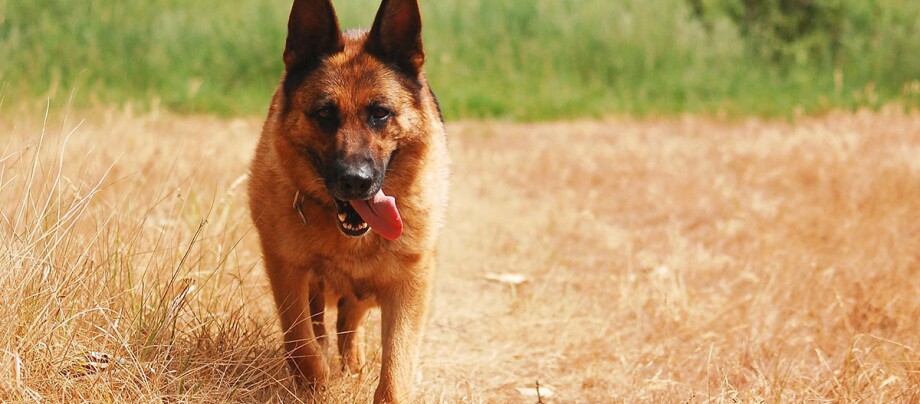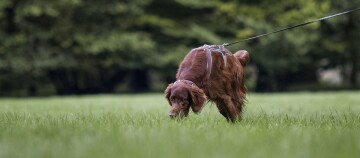German Shepherd Dog – man’s best friend and helper
27.02.2024 - Reading time: 10 minutes

When most people think of a German Shepherd Dog, they imagine a large, impressive animal on an important mission, hunting criminals, sniffing out drugs or herding sheep in the countryside. The German Shepherd Dog is in fact considered the prototype of a working dog. But this smart four-legged friend has a lot more to offer with respect to its versatility.
- German shepherd profile
- A worldwide hit
- What does the German Shepherd Dog look like?
- German Shepherd Dog: Temperament and nature
- How dangerous is the German Shepherd Dog?
- Training and care: Is a German Shepherd Dog ideal for first-time owners?
- How big will a German Shepherd Dog get?
- Caring for a German Shepherd Dog
- Diseases commonly affecting the German Shepherd Dog
- How much does a German Shepherd Dog cost?
- Life expectancy of a German Shepherd Dog
- What to consider before buying a German Shepherd Dog
A worldwide hit
Its name gives away its origins: The German Shepherd Dog breed can trace its lineage back to herding dogs that not only had to watch over the sheep, but were also supposed to guard the shepherd’s property. Going by this definition, early examples of the German Shepherd Dog have been documented since the 7th century. The pioneer breeder, Captain Max von Stephanitz from Dresden, developed the breed from stock-coated and short-haired herding dogs, creating the first breed standard in 1891. Max von Stephanitz created separate rough-coated, smooth-coated and long-coated lines. The dog from which the modern breed is descended, which was purchased by von Stephanitz in 1898, was named “Horand von Grafrath”. The aim was to breed a robust intelligent working dog, while aesthetics were initially a secondary consideration. The German Shepherd Dog is now one of the most popular dog breeds in the world. For a long time, however, it was not permitted to import the animals into Australia. In the past, it was believed that they cross-bred with wolves, causing people to fear that they would mix with dingoes and thus pose a danger to the herds of sheep. This only changed in 1974.
What does the German Shepherd Dog look like?
The German Shepherd is a medium-sized breed; its body is slightly elongated, strong and well muscled. It has a black nose and a powerful bite. It is known for its ‘scissor bite’. This means that its incisors interlock just like scissors. The upper incisors overlap the lower incisors like scissors. A German Shepherd Dog’s ears are medium in size and stand upright. The German Shepherd Dog comes in stock coat, i.e. short-haired, and long-haired varieties. In the stock-coat variety, the outer coat should be as dense as possible and lie close to the body. In the long-haired variety, the outer coat is long, soft and does not lie close to the body. This long-haired variety of the German Shepherd Dog has feathering on its ears and legs and a bushy tail. German Shepherd Dogs with a tan or red base colour and black saddle and other black markings are the most well known. However, German Shepherd Dogs can also be entirely black or black with markings in other colours (e.g. tan or red). German Shepherd Dog coat colours also include white, blue or liver. Incidentally, white German Shepherd Dogs are considered a separate breed: the White Swiss Shepherd Dog.
NewsletterGerman Shepherd
Breed | German Shepherd |
Origin | Germany |
Classification | sheepdogs and cattledogs |
Size | males 60 to 65 cm at shoulder height – females 55 to 60 cm at shoulder height |
Weight | males 30 to 40 kg – females 22 to 35 kg
|
Physique | muscular, longer than they are tall, hanging tail, scissor bite |
Eyes | almond-shaped, slightly slanted
|
Ears | upright ears, angled slightly forward |
Coat and colour | rough-coated, smooth-coated or long-coated; plain black, sable, tan with ‘saddle’, occasionally with markings |
Special features | after the First World War, the breed was known as the Alsatian Wolf Dog in English-speaking countries |
Nature | alert, intelligent and eager to learn, confident, well-rounded, with steady nerves |
Care | regularly comb or brush and occasionally trim coat, clean teeth |
Health | prone to hip and elbow dysplasia, inflammation of the ears and cornea, allergies, tumours, skin problems and much more |
German Shepherd Dog: Temperament and nature
Everything a professional working dog needs is inherent in the nature of German Shepherd Dogs. Their high level of intelligence makes them eager to learn, obedient and docile. The German Shepherd Dog has a well-rounded temperament. It is an alert and confident dog with steady nerves. These qualities are what make it an excellent guard dog. Some people with children might also wish to keep one as a family pet and wonder whether the German Shepherd Dog is good with kids. This breed is in fact a good choice if you are looking for a companion and family dog. Even though German Shepherd Dogs are considered ideal family dogs, they need to be well socialised and trained. A well-rounded German Shepherd Dog is easy-going, good-natured and will stick with you through thick and thin. Its loyalty towards its owners is unwavering. It also enjoys the company of other dogs and, with sufficient socialisation, is well behaved with all breeds. The German Shepherd Dog also typically has a strong instinct to protect.
How dangerous is the German Shepherd Dog?
Some people believe the German Shepherd Dog to be dangerous. As with any breed of dog, a German Shepherd Dog needs good training and socialisation in addition to adequate exercise. This will ensure that your four-legged friend is well-rounded and easy to handle. If the German Shepherd Dog is not properly trained and becomes the leader within the family, it will decide who belongs where in the hierarchy. This can lead, for example, to the dog trying to “train” family members such as children in what it feels is the right way. However, it does not understand that children are more delicate than other dogs, meaning that injuries can occur. It is therefore important to train your German Shepherd Dog appropriately from the beginning and establish a clear hierarchy in which you are the pack leader.
Training and care: Is a German Shepherd Dog ideal for first-time owners?
The German Shepherd Dog is not a dog for beginners. You should be consistent when it comes to training and day-to-day handling. The dog must respect you as leader. If not, German Shepherd Dogs have a tendency towards dominant behaviour or developing overprotective habits or an excessive prey drive. This can quickly lead to problems, and not just because of the animal’s size and strength. The best way to train the eager-to-learn German Shepherd Dog is with patience, empathy, praise and treats. Of course, a well-trained dog also needs sufficient exercise and plenty of movement, no matter what the weather. The German Shepherd Dog’s great enthusiasm for work makes it suitable for a wide range of activities, such as a guard and protection dog as well as an assistance dog and tracker. It also remains a popular herding dog. If you plan for your German Shepherd Dog to be a leisure companion, put these talents to good use by taking part in exciting activities. It will remain playful all his life, and activities such as tracking or mantrailing on a towing line will provide your dog with the stimulation it needs. It is important to make sure that your German Shepherd Dog gets enough exercise during the day. This means around four hours a day. In any case, you will need to do more than just walking your dog for one or two hours a day just so it can do his business. However, the German Shepherd Dog should not climb stairs on a regular basis. Because of this, it is better suited to a home where it will not have to climb stairs every day. This means that this breed is not suitable for keeping in an upstairs apartment. You should be aware of this if you are looking to buy a German Shepherd Dog puppy. You can get further information about training and looking after a German Shepherd Dog from a reputable breeder, for example.
How big will a German Shepherd Dog get?
How big a German Shepherd Dog gets varies between individuals and is also determined by its sex. Males, for example, can reach a height of 60 to 65 centimetres at the shoulders, while females are generally slightly smaller, standing at around 55 to 60 centimetres at the shoulders. Males typically weigh 30 to 40 kilograms and females 22 to 35 kilograms.
Caring for a German Shepherd Dog
Looking after your dog’s coat is fairly easy, although this depends on the length. Regularly brush and comb your German Shepherd Dog, and use a trimmer to neaten up their coat. Take special care to look after your four-legged friend’s teeth. Ideally, its teeth should be cleaned daily – at the very least, the dog should always have dental chews available to prevent tartar build-up. Regular dental care is extremely important because tartar and inflammation in the mouth can, for example, cause your dog to eat less. You can recognise dental problems in your dog by the presence of bloody, very red gums and yellowish or brown deposits on its teeth. This is why it is important to get your German Shepherd used to a dental care routine when it is still a puppy. But bad breath and excessive salivation are other indicators of mouth problems.
A German Shepherd Dog’s eye do not require a great deal of care. If dirt has accumulated in the corners of its eyes, you can easily clean them using a damp but lint-free cloth. The ears do not typically require any special care. The shape of the dog’s ears usually means that the ear canal is able to clean itself. However, occasionally you may need to wipe your German Shepherd Dog’s ears with a damp cloth, then dry them. Your German Shepherd Dog’s claws usually wear down naturally with every walk. However, they may grow too long if you only walk your dog on soft ground. You can get a vet to show you how to trim your dog’s nails at home yourself.
Diseases commonly affecting the German Shepherd Dog
As with many other dog breeds, the German Shepherd Dog is prone to certain diseases that are commonly seen in this breed. Due to their size, bulk and overbreeding, German Shepherd Dogs have a tendency to develop problems with their hip and elbow joints. German Shepherd Dogs are often affected by a hereditary defect of the hip joint, known as hip joint dysplasia. This defect means that the head of the femur does not sit securely enough in the hip socket, causing the joint to partially or completely dislocate. This can cause severe pain in affected dogs and the friction caused by the movement of the loose joint results in the joint wearing down (arthrosis) over time. Elbow dysplasia, in which the parts of the bone which form the joint do not fit together perfectly, is similar. This also leads to pain, lameness and, in its advanced stages, arthrosis. German Shepherd Dogs are also prone to this condition.
How much does a German Shepherd Dog cost?
It is not easy to give an average price for a German Shepherd Dog. The price can vary from breeder to breeder. As a general rule, you can expect to pay a breeder an average of 1,000 to 2,500 euros for a pedigree dog, although the price can, of course, vary depending on the breed. You might also get lucky at an animal shelter or animal welfare organisation.
If getting a dog from an animal shelter, you only need to pay a rehoming fee, which is significantly less.
Life expectancy of a German Shepherd Dog
Before getting a German Shepherd Dog, you should be aware that its life expectancy is 12 to 14 years. Therefore, before buying one, you really need to ask yourself if you will be able to give it a good home for all this time.
What to consider before buying a German Shepherd Dog
If you are looking to buy a German Shepherd Dog puppy, make sure you go to a reputable breeder who cares about their animals’ welfare. Especially if you want to buy a pedigree German Shepherd Dog, a breeder is the right person to turn to. Do plenty of research beforehand to make sure that you understand the breed’s needs and ask yourself whether you are able to meet these requirements. Also bear in mind that the German Shepherd Dog is not ideal for first-time owners and needs to be well socialised and trained. Be aware that a German Shepherd Dog can live more than 12 years and that you will need to make sure that it is cared for all these years. If you are able to provide everything you both need to live together happily, you will have a lot of fun with your four-legged friend.


